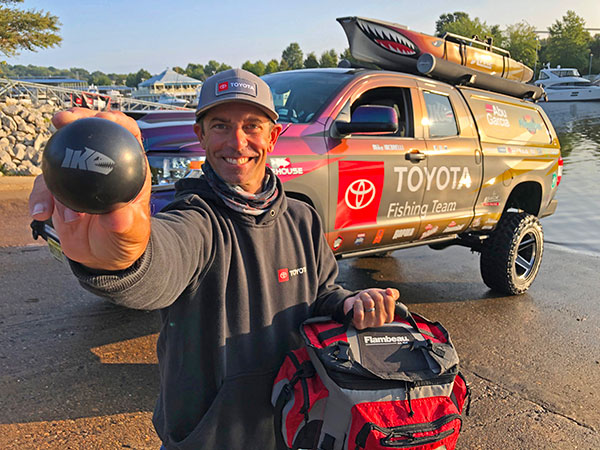- Details
By Al McGuckin
 Iaconelli Is Never Without a Tackle Bag – Or Stress Ball!
Iaconelli Is Never Without a Tackle Bag – Or Stress Ball!
Editor’s note: This is the latest installment of a new series themed “Two from the Tundra” – in which the author asks a Toyota Tundra driving pro angler to pick one special possession, and one special piece of tackle to share with fans.
If you’ve ever thought the outrageous exuberance you’ve witnessed Team Toyota’s Mike Iaconelli exhibit is some sort of made-for-TV stunt --- you’d be wrong. The dude is an all-natural bucket of fishing passion, and he’d be the first to tell you his filter is full of holes.
Hence, it makes perfect sense when “Ike” was asked to pick one special piece of fishing tackle and one unique personal item from his Tundra – both were a reflection of his passion for fishing and the raw emotion with which he does life.
- Details
BFOH Report
The Board of Directors of the Bass Fishing Hall of Fame announces the Hall has awarded four conservation grants this year to contribute to the mission of celebrating, promoting and preserving the sport of bass fishing. The awardees were selected through a highly competitive process, and they represent a diverse group of deserving projects.
“All our Board members are thrilled with the ability to contribute directly to these on-the-ground efforts,” said Bass Fishing Hall of Fame President John Mazurkiewicz. “These grants will help to restore subpar fisheries or to enhance healthy ones, and it’s extra special that two of the projects include efforts from high school bass fishing teams. This fulfills our preservation mandate, and by enhancing opportunities to fish we hope we can help bring new anglers into the sport.”
- Details
Mercury Report
 That First Bass Paved the Way for Zona’s Successful Career
That First Bass Paved the Way for Zona’s Successful Career
An obsession doesn’t often happen in an instant. It tends to start as a budding interest and gains momentum from there.
Not so for Mark Zona, Mercury Pro and host of Zona’s Awesome Fishing Show. At age 4, on a Klinger Lake in southwest Michigan, Zona caught his first bass. That fish would not only spark an immediate and unquenchable passion for fishing, it would set the course for the rest of his life. And if you ask him about catch No. 1, you’ll see he’s no less excited about it today than he was 40-odd years ago.
“I’ve talked to my kids at length about it,” Zona said. “I remember everything about that day. I remember the weather; I remember my lure. I remember every single thing. Of all the things fishing has given my family and me, it’s given us memories that can’t be erased. They’re just so ingrained.
“I say this not from a cliché standpoint, but I want the world to feel that.”





